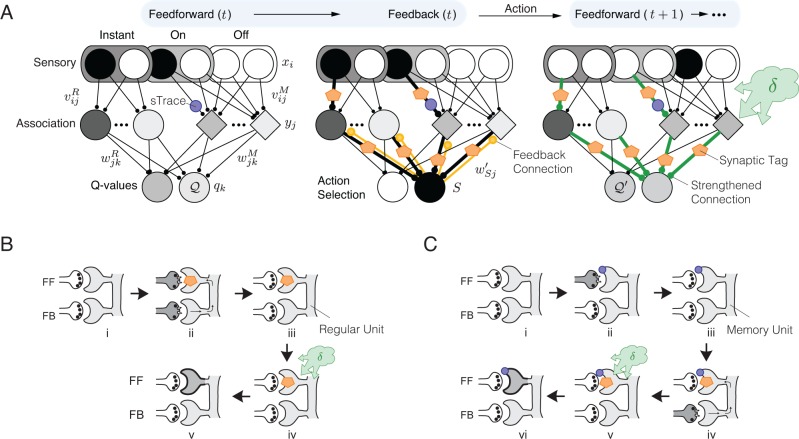Fig 1. Model Architecture.
A, The model consists of a sensory input layer with units that code the input (instantaneous units) and transient units that only respond when a stimulus appears (on-units) or if it disappears (off-units). The association layer contains regular units (circles) with activities that depend on instantaneous input units, and integrating memory units (diamonds) that receive input from transient sensory units. The connections from the input layer to the memory cells maintain a synaptic trace (sTrace; blue circle) if the synapse was active. Units in the third layer code the value of actions (Q-values). After computing feed-forward activations, a Winner-Take-All competition determines the winning action (see middle panel). Action selection causes a feedback signal to earlier levels (through feedback connections , see middle panel) that lays down synaptic tags (orange pentagons) at synapses that are responsible for the selected action. If the predicted Q-value of the next action S′ (QS′) plus the obtained reward r(t) is higher than QS, a globally released neuromodulator δ (see eq. (17)) interacts with the tagged synapses to increase the strength of tagged synapses (green connections). If the predicted value is lower than expected, the strength of tagged synapses is decreased. B, Schematic illustration of the tagging process for regular units. FF is a feed-forward connection and FB is a feedback connection. The combination of feed-forward and feedback activation gives rise to a synaptic tag in step ii. Tags interact with the globally released neuromodulator δ to change the synaptic strength (step iv,v). C, Tagging process for memory units. Any presynaptic feed-forward activation gives rise to a synaptic trace (step ii; sTrace—purple circle). A feedback signal from the Q-value unit selected for action creates synaptic tags on synapses that carry a synaptic trace (step iv). The neuromodulator can interact with the tags to modify synaptic strength (v,vi).

